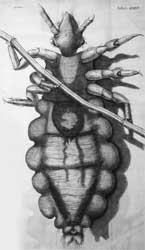|

 A New Hairdo: A louse egg is commonly called a nit. Lice attach their eggs to
their host's hair with specialized saliva which results in a bond
that is very difficult to separate without specialized products.
A nit comb is a comb with very fine close teeth that is used to
scrape nits off the hair. A New Hairdo: A louse egg is commonly called a nit. Lice attach their eggs to
their host's hair with specialized saliva which results in a bond
that is very difficult to separate without specialized products.
A nit comb is a comb with very fine close teeth that is used to
scrape nits off the hair.
Lice Specialization: Lice are highly specialized based on the host species and many
species specifically only feed on certain areas of their host's
body. As lice spend their whole life on the host they have developed
adaptations which enable them to maintain a close contact with the
host. These adaptations are reflected in their size (0.5 mm to 8
mm), stout legs, and claws which are adapted to cling tightly to
hair, fur and feathers, wingless and dorsoventrally flattened. Lice
feed on skin (epidermal) debris, feather parts, sebaceous secretions
and blood. A louse's color varies from pale beige to dark gray;
however, if feeding on blood, it may become considerably darker.
All text is available under the terms
of the GNU Free Documentation License
|